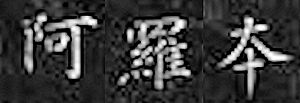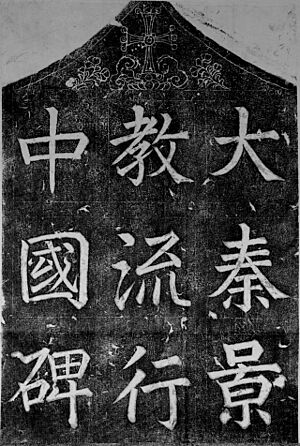Alopen facts for kids
Quick facts for kids Alopen |
|||||||||||||
|---|---|---|---|---|---|---|---|---|---|---|---|---|---|

The name "Alopen" (阿羅本) in the Xi'an Stele.
|
|||||||||||||
| Traditional Chinese | 阿羅本 | ||||||||||||
| Simplified Chinese | 阿罗本 | ||||||||||||
|
|||||||||||||
Alopen (Chinese: 阿羅本, arrived around AD 635) was a Christian missionary. He was the first person we know by name to bring Christianity to China. This happened during the Tang dynasty, a powerful time in Chinese history.
Alopen was a missionary from the Church of the East. This Christian group is sometimes called the "Nestorian Church." He probably spoke Syriac, a language from the Middle East. He might have come from the Sasanian Empire or Byzantine Syria.
We know about Alopen mostly from a special stone monument called the Xi'an Stele. This stone tells us he arrived in Chang'an, the capital city of Tang China, in the year 635. The stele also says that Emperor Taizong of Tang welcomed him. Alopen's arrival marks the beginning of the Church of the East's history in China that we can trace to a specific person.
Alopen's Journey to China

Alopen's name is only known from the Chinese writing on the Xi'an Stele. His name might be a Chinese way of writing "Abraham." Some people think it could also mean "the conversion of God." Another idea is that his name might be a version of "Ruben."
The Stele tells us that Alopen and other missionaries came to China in the year 635. This was the ninth year that Emperor Taizong ruled. They traveled from a place called Daqin, which was what the Chinese called the Byzantine Empire. They brought important religious books and pictures with them.
Alopen likely traveled to China using the famous Silk Road. This was a network of ancient trade routes connecting the East and West.
The Church of the East's mission was successful because Emperor Taizong believed in religious tolerance. This means he allowed different religions to be practiced. His father, Emperor Gaozu of Tang, had been stricter. Gaozu had taken actions against Buddhism and other foreign ideas. But Taizong changed this policy.
太宗文皇帝,光華啓運,明聖臨人,大秦國有上徳曰阿羅本,占青雲而載真經,望風律以馳艱險。貞觀九祀,至扵長安。
In the time of the accomplished Emperor Taitsung, the illustrious and magnificent founder of the dynasty, among the enlightened and holy men who arrived was the Most-virtuous Olopun, from the country of Syria. Observing the azure clouds, he bore the true sacred books; beholding the direction of the winds, he braved difficulties and dangers. In the year AD 635 he arrived at Chang-an.—Extract from the Xi'an Stele, about the arrival of Alopen.
Christianity in Tang China
The Stele says that Emperor Taizong welcomed Alopen. The emperor arranged for the holy writings Alopen brought to be translated. This happened at the Imperial Library. Taizong was a great scholar and supporter of learning. After studying the writings, he found them very good. He then arranged for them to be shared with others.
Four important Christian writings from this early time in China date back to Alopen's period. Three years later, in 638, Emperor Taizong made an official announcement. This declaration protected the Church of the East. He also built China's first Christian church. He recognized twenty-one priests, who were probably all from Persia, to lead the church.
Emperor Taizong's son, Emperor Gaozong of Tang, became the next ruler. He continued his father's policy of religious tolerance. Under Gaozong, Alopen's importance grew even more. He was appointed a bishop. This meant he was in charge of the many churches the emperor had built.
Emperor Taizong believed in allowing different religions to exist peacefully. He even included ideas from various religions in his own beliefs. These included Taoism, Confucianism, Buddhism, Zoroastrianism, Judaism, and Islam. He made laws that encouraged his people to be tolerant of different faiths. Alopen and Emperor Taizong respected each other.
After Alopen's time, the Church of the East remained important in China. This lasted for the rest of the Tang Dynasty. Different emperors treated the Church differently. Some continued to be tolerant, like Taizong. Others openly persecuted, or harmed, Christians.
The Church of the East disappeared when the Tang Dynasty fell in the early 10th century. It did not return for about 300 years. It was brought back to China later by the Mongols.
Alopen's story became well-known again in the 17th century. This happened when the Xi'an Stele was rediscovered. People in China were surprised to learn that Christianity, which new missionaries were preaching, had actually been in China more than 1,000 years earlier.
See also
- Adam (monk)

